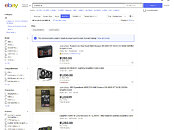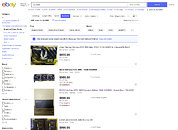Monday, January 11th 2021

We're Changing How we Handle Pricing in Graphics Card Reviews
The major GPU releases in 2020 are all plagued by the same problem: good product, not enough stock. This has led to a perverse situation on the market: you can't just walk into your favorite store and purchase the product you want. This is a consequence of NVIDIA and AMD going to market with tiny volumes, and extremely optimistic MSRPs which opened up the market to the phenomenon of scalping. Scalpers are individuals, or groups, who buy up whatever little volume is available, often using sophisticated online shopping bots, and resell them at exorbitant premiums on marketplaces like eBay, for profit.
This system only works because there is zero retail stock available anywhere on the planet, and whatever volume comes in, is so low that it evaporates, often before hitting retailer shelves. The only way scalping can be defeated is for manufacturers to flood the market with large volumes of product that the scalpers cannot scale their purchases up to, and possibly for crypto-currency mining to become not worth it on the latest generations of graphics cards. Until these happen, marked-up pricing is an inescapable reality for consumers.We believe that exposing readers to MSRP pricing alone in our graphics card reviews, would be doing them disservice. That's why I've decided to consider the pricing of the lowest valid eBay.com listing in my graphics card reviews, too, in cases where none are available on our main retail pricing source, Newegg.com. We do not condone the practice of scalping, but at the same time, it's just not right to report and discuss prices that you can't actually buy the product at.
How We Reported Graphics Card Prices in Our Reviews Until Now
If a price is available on Newegg for the tested product, use that. If not available, possibly because day-one review, for which no other source of information exists, use the MSRP. For the huge list of "reference" comparison cards in reviews, the cheapest Newegg price of the series is used. For older cards, which are no longer in production, the Newegg price can often be too high, because 3rd party sellers are trying to profit. In that case the last available reasonable price point is considered.
How We Intend to Report Pricing Now
I'll try to determine pricing by first looking it up on Newegg, and only use the Newegg price if the product is available (ready to purchase and ship) at the time of writing. For older products nothing changes. If a product is completely sold out on Newegg, like all GeForce RTX 30 and Radeon RX 6800/6900 Series currently, I will look it up on eBay, which is one of the leading marketplaces where people resell their graphics cards.
The search uses the following parameters:
For example, for a hypothetical RX 6700 XT, which is 15% slower than the RX 6800 non-XT (currently going for $850 on eBay, MSRP was $580), I would estimate $700 ($850, minus 15%, minus some premium for lower absolute performance). Obviously this isn't going to be 100% perfect, but I feel that will be more useful than simply parroting back "the MSRP is $400, super affordable, just buy it".
In the review's conclusion I will discuss MSRP, supply situation, the current market price and how that compares to other alternatives on the market. The Performance per Dollar charts will now have the price for calculation appended after the product name. When the MSRP is used, a pink bar with price/performance at MSRP gets added. Comparison cards (gray bars) will be shown at their street price only, MSRP won't be listed. The chart below should illustrate this sufficiently.We welcome your comments and constructive feedback.
This system only works because there is zero retail stock available anywhere on the planet, and whatever volume comes in, is so low that it evaporates, often before hitting retailer shelves. The only way scalping can be defeated is for manufacturers to flood the market with large volumes of product that the scalpers cannot scale their purchases up to, and possibly for crypto-currency mining to become not worth it on the latest generations of graphics cards. Until these happen, marked-up pricing is an inescapable reality for consumers.We believe that exposing readers to MSRP pricing alone in our graphics card reviews, would be doing them disservice. That's why I've decided to consider the pricing of the lowest valid eBay.com listing in my graphics card reviews, too, in cases where none are available on our main retail pricing source, Newegg.com. We do not condone the practice of scalping, but at the same time, it's just not right to report and discuss prices that you can't actually buy the product at.
How We Reported Graphics Card Prices in Our Reviews Until Now
If a price is available on Newegg for the tested product, use that. If not available, possibly because day-one review, for which no other source of information exists, use the MSRP. For the huge list of "reference" comparison cards in reviews, the cheapest Newegg price of the series is used. For older cards, which are no longer in production, the Newegg price can often be too high, because 3rd party sellers are trying to profit. In that case the last available reasonable price point is considered.
How We Intend to Report Pricing Now
I'll try to determine pricing by first looking it up on Newegg, and only use the Newegg price if the product is available (ready to purchase and ship) at the time of writing. For older products nothing changes. If a product is completely sold out on Newegg, like all GeForce RTX 30 and Radeon RX 6800/6900 Series currently, I will look it up on eBay, which is one of the leading marketplaces where people resell their graphics cards.
The search uses the following parameters:
- Brand new
- Ships to the USA
- Sort pricing by "lowest first" (price+shipping)
- Manually inspect and filter out individual listings that look "fake"
- The listing must be ready to purchase ("Buy it Now"), and must ship within 7 days of receipt of payment (ensures that the scalper physically possesses the merchandise they're trying to sell)
For example, for a hypothetical RX 6700 XT, which is 15% slower than the RX 6800 non-XT (currently going for $850 on eBay, MSRP was $580), I would estimate $700 ($850, minus 15%, minus some premium for lower absolute performance). Obviously this isn't going to be 100% perfect, but I feel that will be more useful than simply parroting back "the MSRP is $400, super affordable, just buy it".
In the review's conclusion I will discuss MSRP, supply situation, the current market price and how that compares to other alternatives on the market. The Performance per Dollar charts will now have the price for calculation appended after the product name. When the MSRP is used, a pink bar with price/performance at MSRP gets added. Comparison cards (gray bars) will be shown at their street price only, MSRP won't be listed. The chart below should illustrate this sufficiently.We welcome your comments and constructive feedback.



56 Comments on We're Changing How we Handle Pricing in Graphics Card Reviews
Yeah doesn't help for miners and scalpers though, only accounts for actual gamers supply.
I ran to my local Micro Center yesterday due to seeing a small amount of Zen 3 CPUs were listed as "in stock". I didn't notice any stock quantities listed online for GPUs (RTX 3070/3080/3090 and RX 6800/XT), but apparently they did get some in.
I arrived at Micro Center about 10 minutes after they opened. You had to wait outside in the cold (thank fully it wasn't too cold, only around 25F) or your car after getting a number for any DIY computer hardware. About half the folks outside where there for either a GPU or CPU and some for both. When I got there the manager out front was announcing what they had left in stock for CPUs and GPUs:
- 5600X - couple left (I think they started with 6)
- 5800X - about a dozen left (I think they started with 20)
- 5900X - about 20 left (they started with 24 or 25)
- AMD 6800/XT - only a couple (these sold out first)
- RTX 3070 - 12 left of the 20 that came in (about 10 minutes before I got into the store they were all sold out)
- RTX 3080 - about 10 came in (same as the 3070, gone before I got in)
- RTX 3090 - got in 6 (4 were left when I got in, but I'm not dropping that much for a GPU, ever. If they had any 3070 or 6800 cards I would have picked one up, they are in my budget range)
There were still a good 30+ people outside waiting when they announced they were sold out of the all GPUs except the 4 RTX 3090. About half the crowd left.When I got inside and stood there waiting for my chance they just sold their last 5800X before me and only had 2 5900X left - so I picked up a 5900X.
This was the biggest shipment of GPUs the guy helping me said they received since the initial launch of them all. Usually they get a maybe a half dozen here and there. Yesterday evening they got in almost 40 cards in total and they were all sold within the first 30 minutes of opening. The AMD CPUs they get in small batches like this, usually around 2-5 dozen once or twice a week, certainly a lot more than GPUs, but they don't sit on the shelves very long....generally sell out the same day they stock them.
I am not sure shy some are against the idea, in the UK most of the AIB GPUs MSRP is not even legal (for a MSRP to be legal the bulk of product has to be sold at that price).In my opinion the official MSRP should not even be mentioned if its a la la land price. e.g. there is only one model of the 3080 now which can claim a valid MSRP, the founders edition, all the AIB cards have had several price increases at the distributor level, even before we consider ebay scalping.
It's always a buyers market
No buyers = prices drop.